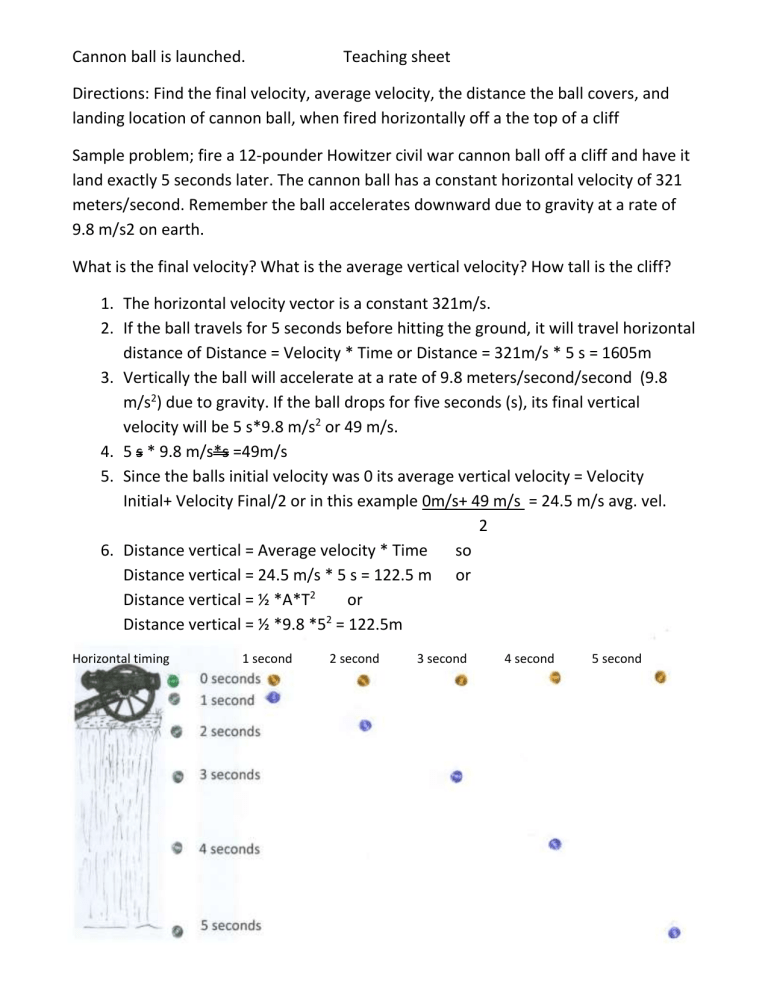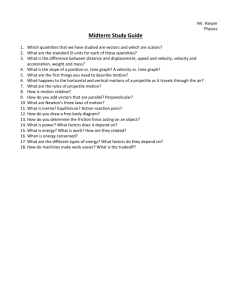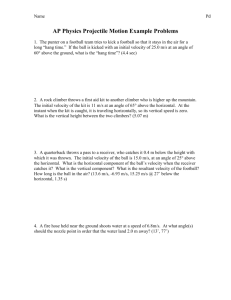Projectil motion in vertical and horizontal directions, teaching sheet

Cannon ball is launched. Teaching sheet
Directions: Find the final velocity, average velocity, the distance the ball covers, and landing location of cannon ball, when fired horizontally off a the top of a cliff
Sample problem; fire a 12-pounder Howitzer civil war cannon ball off a cliff and have it land exactly 5 seconds later. The cannon ball has a constant horizontal velocity of 321 meters/second. Remember the ball accelerates downward due to gravity at a rate of
9.8 m/s2 on earth.
What is the final velocity? What is the average vertical velocity? How tall is the cliff?
1.
The horizontal velocity vector is a constant 321m/s.
2.
If the ball travels for 5 seconds before hitting the ground, it will travel horizontal distance of Distance = Velocity * Time or Distance = 321m/s * 5 s = 1605m
3.
Vertically the ball will accelerate at a rate of 9.8 meters/second/second (9.8 m/s 2 ) due to gravity. If the ball drops for five seconds (s), its final vertical velocity will be 5 s*9.8 m/s 2 or 49 m/s.
4.
5 s * 9.8 m/s*s =49m/s
5.
Since the balls initial velocity was 0 its average vertical velocity = Velocity
Initial+ Velocity Final/2 or in this example 0m/s+ 49 m/s = 24.5 m/s avg. vel.
6.
Distance vertical = Average velocity * Time so
2
Distance vertical = 24.5 m/s * 5 s = 122.5 m or
Distance vertical = ½ *A*T 2 or
Distance vertical = ½ *9.8 *5 2 = 122.5m
Horizontal timing 1 second 2 second 3 second 4 second 5 second
Notes about the sketch.
Green Cannon Ball is time zero for vertical, horizontal and trajectory path.
Yellowish brown cannon ball is the horizontal projectile path if not affected by gravity.
Grey/Black is the gravitational projectile path if only affected by gravity.
Blue is the actual projectile path the cannon ball will travel
Sometimes solve for Time using T= √ 2D
A
Where T= Time in Seconds
D= Distance in meters
A= Acceleration due to gravity
Using vector addition, the final velocity of the cannon ball is:
A 2 + B 2 = C 2
49 2 + 321 2 = C 2
2401+103041 = c 2
105442 = c 2
C= 324.71 m/s
Vertical Gravitational
Vector 49 m/s
Resultant velocity vector at impact.
Horizontal velocity vector 321 m/s
Using vector addition the cannon ball lands:
Vertical distance traveled 122.5m
A 2 + B 2 = C 2
122.5
2 +1605 2 =C 2
15006.25+2576025 =C 2
2591031 = C 2
1609.668m
Resultant vector shows the distance the cannon balled traveled 1609.688m
Horizontal Distance traveled 1605 meters
Name ______________
Assignment sheet
Date
Cannon ball is shot from cannon.
Directions: Find the time the cannon ball flies when shot from a cannon located on a cliff 1000 meters tall traveling horizontally at a velocity of 321 meters per second.
Determine how far away from the base of the cliff does the cannon ball land. Find the final velocity at impact. . Show formulas, substitution and answers.
Sample sketch. Not specific to problem above
Time of Flight
Distance away from base of cliff to landing
Final Velocity at impact
Answer Key
Time of Flight
T = √ 2D/A
T=
√
2*1000m/9.8m/s 2
T= 14.285s
Distance from base to landing
V horizontal
* T = D horizontal
321m/s * 14.285s = D horizontal
D horizontal
= 4585.485 meters
Final Velocity at Impact
Vertical Velocity at impact
V final
= AT
V final
= 9.8m/s 2 * 14.285s
V final
= 139.993 m/s
Horizontal velocity at impact
V final
= 321 m/s
Final velocity at impact
A 2 + B 2 = C 2
V 2 = 321 2 + 139.993
2
V 2 = 103041+ 19598.04
V 2 = 122639.04
V final
= 359.199 m/s





